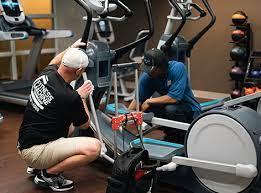Gym equipment is the backbone of any fitness facility, powering countless workouts and helping individuals achieve their fitness goals. However, like any machinery, gym equipment is prone to wear and tear over time. From treadmills and elliptical machines to weight benches and squat racks, every piece of equipment requires proper maintenance and occasional repairs to ensure optimal performance and safety. In this comprehensive guide, we'll delve into the world of repairing gym equipment, equipping you with the knowledge and skills to keep your gym gear in top-notch condition.
Understanding Common Issues
Before diving into repairs, it's crucial to identify common problems that plague gym equipment. Some frequent issues include:
-
Malfunctioning Electronics: Treadmills, ellipticals, and stationary bikes often rely on electronic components for functions like speed control, incline adjustments, and heart rate monitoring. Problems with wiring, circuit boards, or sensors can lead to erratic behavior or complete failure.
-
Worn-out Belts and Cables: Treadmill belts, elliptical drive belts, and cables on weight machines can degrade over time due to friction and usage. Cracks, fraying, or slackness in these components can compromise safety and performance.
-
Faulty Bearings and Bushings: Moving parts such as rollers, pulleys, and pivot points rely on bearings and bushings for smooth operation. When these components wear out or become damaged, they can produce squeaking noises, cause uneven motion, or lead to instability.
-
Structural Damage: Heavy-duty gym equipment like power racks and weight benches can suffer structural damage from prolonged use or misuse. This may manifest as bent frames, cracked welds, or loose bolts, posing serious safety hazards.
Tools of the Trade
To tackle gym equipment repairs effectively, you'll need the right tools for the job. Here are some essential tools commonly used in equipment maintenance:
-
Screwdrivers: Phillips and flat-head screwdrivers of various sizes are indispensable for disassembling and reassembling equipment.
-
Allen Wrenches: Many gym machines use hex bolts, requiring Allen wrenches for loosening or tightening.
-
Adjustable Wrench: Useful for tightening nuts and bolts of different sizes, an adjustable wrench is a versatile tool in equipment repair.
-
Multimeter: For diagnosing electrical issues, a multimeter helps measure voltage, resistance, and continuity in circuits.
-
Lubricants: Silicone spray lubricant or grease can be applied to moving parts to reduce friction and extend their lifespan.
-
Replacement Parts: Keep a stock of commonly used replacement parts such as belts, cables, bearings, and bushings for quick repairs.
Troubleshooting and Repairs
Now that you're equipped with the necessary tools let's explore some common repair scenarios and how to address them:
-
Treadmill Belt Replacement: If your treadmill belt is worn or frayed, it's time for a replacement. Start by unplugging the treadmill and removing the motor cover. Loosen the belt tension and slide off the old belt. Install the new belt by following the manufacturer's instructions, ensuring proper alignment and tension.
-
Elliptical Drive Belt Adjustment: If your elliptical machine makes squeaking noises or has uneven resistance, the drive belt may need adjustment. Access the drive system by removing the side covers and locate the drive belt. Adjust the tension by tightening or loosening the tensioning bolts until the belt has proper tension and alignment.
-
Electronics Troubleshooting: If your exercise bike's console isn't displaying information or responding to inputs, start by checking the power source and connections. Use a multimeter to test for voltage at the power input and inspect wiring for any visible damage. If necessary, replace faulty components such as circuit boards or sensors.
-
Bearing and Bushing Maintenance: Regularly inspect bearings and bushings for signs of wear or damage. If you notice squeaking or rough motion, it's time to lubricate or replace these components. Disassemble the affected part, clean out old lubricant and debris, and apply fresh lubricant before reassembly.
-
Structural Repairs: For structural damage like bent frames or cracked welds, it's crucial to address the issue promptly to prevent accidents. Depending on the severity of the damage, you may need to reinforce welds, replace bent components, or seek professional welding services for complex repairs.
Preventive Maintenance
In addition to reactive repairs, implementing a preventive maintenance schedule can help prolong the lifespan of your gym equipment and minimize downtime. Here are some preventive maintenance tasks to consider:
-
Regular Cleaning: Dust, sweat, and debris can accumulate on equipment, leading to premature wear and corrosion. Clean equipment regularly with a mild detergent and disinfectant, paying special attention to moving parts and electronic components.
-
Lubrication: Apply lubricant to pivot points, bearings, and cables according to the manufacturer's recommendations to ensure smooth operation and prevent rust and corrosion.
-
Tighten Loose Bolts: Periodically inspect equipment for loose bolts and fasteners and tighten them as needed to maintain structural integrity.
-
Check Alignment and Tension: Verify that belts, cables, and chains are properly aligned and tensioned to prevent slippage and premature wear.
-
Inspect Electrical Components: Check wiring, connectors, and circuit boards for signs of damage or corrosion, and repair or replace any faulty components promptly.
Conclusion
Repairing gym equipment is a crucial aspect of maintaining a safe and functional fitness facility. By understanding common issues, acquiring the right tools, and implementing a proactive maintenance strategy, you can ensure that your gym equipment remains in top condition, providing reliable performance for years to come. Remember, safety should always be the top priority, so if you encounter complex repairs beyond your expertise, don't hesitate to seek professional assistance. With proper care and attention, you can keep your workout gear in peak condition and enjoy a revitalized fitness experience.



